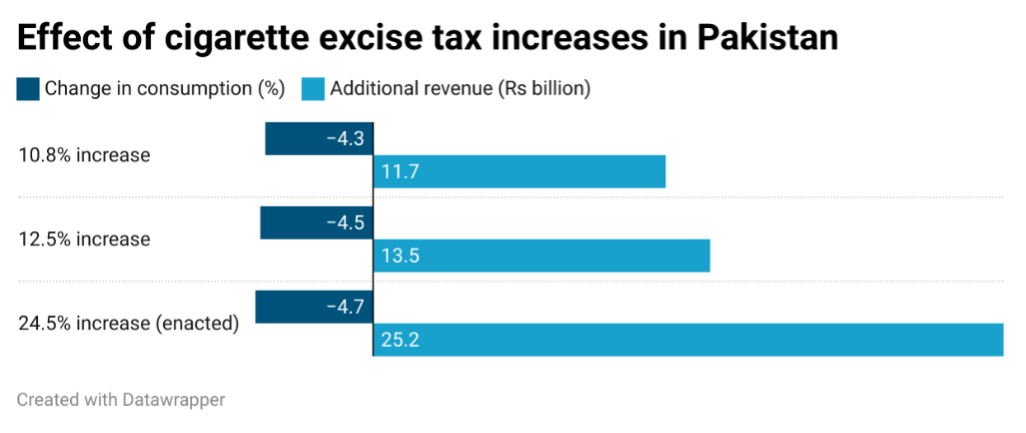Looking Back on 2022: A Round-Up of Research on Tobacco from Asia
In Asia, many governments are failing to implement tobacco tax policies that align with evidence-based best practices. As a result, consumption continues to threaten the wellbeing of smokers, their families, countries, and the region as a whole. The first step to improving these tax policies is to produce and disseminate rigorous economic research on the topic. We worked with six think tanks in 2022 to do exactly that through a number of reports, working papers, policy briefs, policy notes, and fact sheets.
The evidence produced in Indonesia and Pakistan demonstrates the repercussions of tobacco use for entire households. In Indonesia, Center for Indonesia's Strategic Development Initiatives (CISDI)’s study found that smoking households dedicate 11% of their monthly budget to tobacco. This diverts funds from necessities and other beneficial goods and services, including food, housing, and health care, especially among low-income households. Simultaneously, tobacco spending is associated with increased spending on sugar-sweetened beverages (SSBs) and ready-made foods. These spending behaviors result in a lower daily nutrition intake in smoking households that threatens the long-term health and development of youth.
Two think tank partners in Indonesia and Pakistan dove deeper into this effect on children with similarly troubling results. Universitas Gadjah Mada (UGM) estimated that a 7% increase in household cigarette expenditure in Indonesia would increase stunting risk among children in the household by 25.6% with average reductions in height and weight by 9.7% and 13.7%, respectively. In Pakistan, research from Pakistan Institute of Development Economics (PIDE) found that over 20% of children in Pakistan live with parents who smoke. These children, and especially those with mothers that smoke, are more likely to be stunted than their counterparts with non-smoking parents. In both countries, the association between smoking in households and stunting was stronger among the poor and those in rural areas. These findings may have negative implications for the region as a whole, as youth who experience stunting are likely to face health problems for the rest of their lives.
Recently, both Bangladesh and Pakistan raised excise taxes on tobacco. Unfortunately, the modest increase in Bangladesh does not keep pace with inflation or income growth. The National Budget for fiscal year 2022-23 in Bangladesh included only a minor price increase while maintaining the complex four-tier tax structure. In Pakistan, on the other hand, policy makers raised the Federal Excise Duty (FED) tax rate several times, with the final version of Tax Law Ordinance 2022 expected to result in substantial fiscal and public health benefits.
The Institute of Health Economics (IHE) estimated the impact of the new National Budget in Bangladesh on cigarette sales, smoking prevalence, and tax revenue. As cigarettes become more affordable under this reform, sales would increase by 109 million packs, and smoking prevalence would only decrease minimally, 15.1% to 14.8%. The researchers compare these outcomes to a more effective alternative, which would raise the excise tax rate to 65% and increase the minimum price of all brands. Under this alternative, sales of cigarettes would decrease by 71.9 million packs, while raising an additional BDT 65 billion in tax revenue compared to the passed reform. Further, smoking prevalence would decrease to 14%.
In Pakistan, the Social Policy and Development Centre (SPDC) simulated the proposed excise tax increase (average of 10.8%) followed by the tax increase passed by Finance Act 2022 (average of 12.5%), and finally the further increase passed by Tax Law Ordinance 2022 (weighted average of 24.5%). While all of the scenarios would somewhat reduce consumption and raise additional revenues, the researchers estimate that the excise tax increase of 24.5% will have a much larger positive impact (chart below). The 24.5% increase is even expected to encourage 400,000 adult smokers to quit and prevent 435,000 youth from becoming smokers.

Both Bangladesh and Pakistan face challenges with complex tax structures and tax administration. In Bangladesh, there is a significant price gap between low- and high-tier cigarettes. Research from IHE found that, as a result, smokers may switch to cheaper brands when faced with a price increase. A 10% increase in the price of high-price cigarettes would increase consumption of low-price cigarettes by 2.6%. British American Tobacco (BAT) successfully took advantage of this system by introducing a new low-price brand. Estimates from ARK Foundation show that this shift decreased government tax revenues by between 2.73 and 9.84 billion BDT. Replacing the tiered structure with a uniform ad valorem tax rate in addition to raising the base price of low-tier cigarettes would substantially improve tax collection in the country.
Problematically, manufacturers in Pakistan self-report production to tax authorities without any external oversight. This arrangement incentivizes the industry to under-report production to evade taxes. SPDC estimated the size of this under-reporting, as well as the resulting revenue loss. Between 2018 and 2021, manufacturers under-reported by around 8%, or 4 billion cigarettes annually. This translates to PKR 25.9 billion in lost revenue over the three years. Industry under-reporting is a significant component of the overall illicit trade in Pakistan. Furthermore, trends reveal that manufacturers increase cigarette production—called “front loading”— prior to the release of the budget in an effort to avoid upcoming tax increases.
The evidence above tells a compelling story about the importance of tobacco control and tobacco taxation across the region. Existing tobacco tax systems are insufficient to deter users from smoking, while allowing tobacco companies to profit and continue to build their consumer base. However, policy makers have the opportunity to apply these findings to inform more effective tax policies that would improve the public health of constituents and raise additional revenues in the future.
